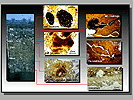
The hydromorphic conditions of the soil remain reflected in its profile.
Normally, the saturation with water is not homogeneously spread over the whole soil, but a vertical gradient exists, in such a way that starting from the water level, the horizons are less and less affected by hydromorphism.
Therefore a hydromorphic soil normally shows a vertical sequence of its redoximorphic features.
![]() Accumulation features and the soil profile
Accumulation features and the soil profile
The nodules and coatings are concentrated in the upper horizons of the soils, by preference in the zones of fluctuation of the water table and decreasing with depth.
During the dry period the solutions with dissolved Mn++ and Fe++ rise by capillarity and concentrate by oxidation, forming in these horizons abundant Fe/Mn accumulations.
It is evident that with increasing humidity also the accumulations increases, although, they do not occur in extremely humid soils as alternation of dry and humid periods are essential for their formation. This may explain why the maximum of accumulations always occurs above the horizon with maximum formation of mottles described in the field.
![]() Depletion features and the soil profile
Depletion features and the soil profile
The bleached nodules, flecks and coatings are formed preferentially in the zone of fluctuating water levels, giving rise to mottled horizons, where bleached zones alternate with zones not subject to leaching.
In poorly drained soils they are situated slightly above the highest level reached by the water table and in the better drained soils they are situated slightly below this level. These are the traditional pseudogley horizons, subject to temporary reducing conditions, alternating with oxidizing ones.
Iron - and clay - deficient hypo-coatings seem to form in the B horizon near its contact with the A horizon. In the case of Bt horizons they form above the zone of maximum clay content. They correspond with gray mottles observed in the profile and with tongues if present. They are situated at the surface of peds limited by large voids.
Frequently they occur immediately below the level of maximum Fe/Mn nodules content.
If the conditions of saturation subsist continuously during the year, the reducing conditions predominate, the iron forms ferrous compounds, the profile acquires a gray bluish green color and gley formation takes place. When the soil undergoes more or less important phases of seasonal drying (for instance by fluctuations of the water table), an alternation of oxidizing and reducing conditions is created, and numerous reddish stains appear, due to ferric components, near to other, more or less bluish or greenish grayish zones, corresponding to ferrous components. A mottled horizon appears which in this case corresponds to the process of pseudogley formation. In many cases, when the soil is not so impermeable, the Fe++ and Mn++ is mobilized during phases of reduction and eliminated from the profile, leaving large bleached zones.
![]() Pseudogley profiles
Pseudogley profiles
The hydromorphism of a pseudogley is typic for soils with strongly expressed illuvial clay accumulation. Under these conditions a marked textural contrast exists with the more sandy overlying E horizon. The marked difference in permeability of both horizons makes that the precipitation water is retained at the contact, forming a perched water table.
These soils are typic for regions with contrasting climates, and a long and dry summer. The hydromorphic reducing conditions prevail only during the humid season and are therefore not very strong.
The hydromorphic conditions remain reducing in a narrow fringe, the zone of perched water, which presents flecked colors with abundant bleaching of the groundmass of the horizon.
The hydromorphic character decreases towards the surface of the soil, with abundant accumulations of Fe/Mn, forming nodules and coatings. The lower part of the profile lacks indications of hydromorphism.
![]() Profiles with gley in the subsurface horizons
Profiles with gley in the subsurface horizons
If the permanent water table is not situated at the surface of the profile, but at a given depth, it is evident that above this level horizons with distinct degrees of hydromorphism occur, due to seasonal fluctuations of the phreatic level, and the differential rise of the water by capillarity. From the gray horizon, in the deeper part of the soil, till the soil surface a sequence of hydromorphic levels, decreasing in intensity, is observed, comprising all morphological features described.
The zone of permanent saturation consists of a gray-colored horizon, whereas the zone of fluctuations forms a mottled horizon and obviously grayish mottles will be more abundant in the lower part of this horizon than near its upper boundary which is more remote from the saturated zone.
Finally, above all this, a colored horizon is observed,
without mottles with low chroma, although nodules and coatings of Fe, and
especially Mn, may be present, which need less pronounced reducing conditions.
![]() Profiles with gley in the surface horizon
Profiles with gley in the surface horizon
These soils present an intense hydromorphism affecting all soil horizons. It are soils with a bleached groundmass (greenish bluish gray), without accumulation with high chroma, in all its mineral horizons.